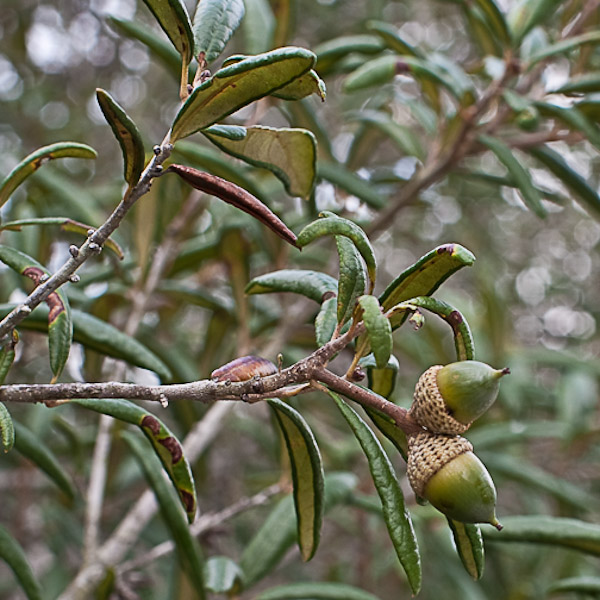Quercus virginiana
Fagaceae

Live Oak by John Bradford
Today John and George explored Halpatioke Park along the South Fork of the St. Lucie River. We experienced botanico-diversity, witnessing mighty Live Oak Trees supporting a dozen species of epiphytes from liverworts to orchids, mostly southern needleleaf bromeliads. Nothing like mighty oaks to get a person thinking about little acorns. Today’s blog required collusion. Doing much of the research, John started it. Or to step back further, Dee (see the blog authorship) was the ringleader. Dee studies Scrub Jays. Scrub Jays fancy acorns. Dee and John started looking into acorn species preferences among the jays. They’re the brains of this oaky operation.
An acorn is a wonderful little space capsule for an oak embryo. Hard on the outside, loaded with food on the inside, and with self-defense. It is the oak fruit, containing one lonesome seed. The cute little cap is a cluster of tiny modified leaves, bracts, not part of the fruit.

Acorns by JB. The cap is a leaf cluster. The pointy tip is the style from the female flower whose ovary became the the acorn.
Acorns are loaded with nutrition appreciated by weevils, by birds especially jays, and by rodents, especially squirrels. Weevils alone can destroy a substantial portion of an acorn crop. Jays and squirrels feast on acorns, but there’s a tradeoff, the animals disperse surviving acorns in the process.
If everybody wants to eat you, you need protection. The main anti-nibbling ingredient in acorns is tannin, as in tan your hide. Tannins bind up the salivary proteins in the mouth and digestive systems of herbivores and they suppress microbes. We exploit that ability to preserve leather.
The interesting thing John and Dee discovered is that tannin distribution is not even throughout the acorn, especially in the Red Oak Group, defined below. The critical vital portion of the embryo is toward the acorn’s pointy tip where the acorn concentrates tannins. The more expendable portion is the cap end. Creatures eating such acorns tend to reject, relocate, and maybe even bury, the nasty part which retains the ability to sprout.

The vital part of the embryo is toward the pointy tip. In this photo see the base of the embryo, the future root, near the acorn tip. It will pop forth soon, as shown in the following three photos.

Peek-a-boo


As germination progresses, the young root headed down and the young shoot headed up become displaced from the acorn with the food-rich seed leaves (cotyledons) remaining inside the acorn and continuing to feed the baby, as visible below.

The acorn with the cotyledons inside is to the left. The young shoot rises toward the top left corner. The young root in Live Oak develops a thickening, pointing to the lower right, presumably protecting the young tree from fire or other aboveground peril.

Much later, the root thickening enlarged. By JB.
Tannin is not evenly distributed among species. The species in the Red Oak Group, locally including Myrtle Oak and Sandhill Oak, tend to have especially bitter acorns especially repugnant to distributors yet more likely to be only partially eaten non-fatally. When animals bury acorns they are more often from the Red Oak Group. Such acorns surviving storage are effectively relocated and planted. They correspondingly tend to be slow to germinate. Scrub Jays reportedly prefer such high-tannin acorns for caching, spotting them because they have less insect damage than the low-tannin alternatives.
The White Oak Group, including today’s Live Oaks as well as Chapman’s Oak and Sand Live Oak, tend to have more-edible acorns probably more attractive to distributors yet also more susceptible to destruction. These acorns tend to be dispersed less than the Red Oak acorns, staying nearer the parent tree, and germinating quickly. Some years, mast years, the trees make acorns in such massive quantities that overmatch the nibblers.
Low tannin is why deer and humans prefer White Oak acorns. Don’t try it. Tannins are bad for you, and who knows what else is present. Yet if you belonged to any of many acorn-eating cultures around the world you might have enjoyed acorns most often ground to flour, leached, and made into mushes, porridges, cakes, and breads.

Quercus geminata…the twins as in Gemini. By JB.
Dig deeper:
https://www.sciencedaily.com/releases/1998/11/981126102802.htm
theshrubqueen
January 26, 2019 at 8:47 am
Very cool. A friend who is a hunter complains about how bad acorn eating turkeys taste, The cure, butter.
George Rogers
January 26, 2019 at 2:48 pm
Butter would make worms taste good.
Flower Roberts
January 28, 2019 at 9:22 am
This was fascinating. Thanks